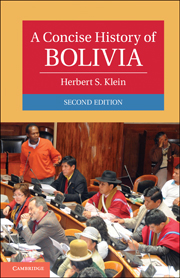Book contents
- Frontmatter
- Contents
- Preface to the Second Edition
- Preface to the First Edition
- 1 GEOGRAPHY AND PRE-COLUMBIAN CIVILIZATION
- 2 THE CREATION OF A COLONIAL SOCIETY
- 3 LATE COLONIAL SOCIETY: CRISIS AND GROWTH
- 4 REVOLUTION AND THE CREATION OF A NATION-STATE, 1809–1841
- 5 THE CRISIS OF THE STATE, 1841–1880
- 6 THE AGES OF SILVER AND TIN, 1880–1932
- 7 DISINTEGRATION OF THE ESTABLISHED ORDER, 1932–1952
- 8 FROM THE NATIONAL REVOLUTION TO THE COLD WAR, 1952–1982
- 9 CREATING A MULTIETHNIC DEMOCRACY, 1982–2002
- 10 THE EMERGENCE OF A MESTIZO AND INDIGENOUS ELITE, 2002–2010
- Political Chronology
- Tables
- Bibliography
- Index
- Titles in the series
5 - THE CRISIS OF THE STATE, 1841–1880
Published online by Cambridge University Press: 01 June 2011
- Frontmatter
- Contents
- Preface to the Second Edition
- Preface to the First Edition
- 1 GEOGRAPHY AND PRE-COLUMBIAN CIVILIZATION
- 2 THE CREATION OF A COLONIAL SOCIETY
- 3 LATE COLONIAL SOCIETY: CRISIS AND GROWTH
- 4 REVOLUTION AND THE CREATION OF A NATION-STATE, 1809–1841
- 5 THE CRISIS OF THE STATE, 1841–1880
- 6 THE AGES OF SILVER AND TIN, 1880–1932
- 7 DISINTEGRATION OF THE ESTABLISHED ORDER, 1932–1952
- 8 FROM THE NATIONAL REVOLUTION TO THE COLD WAR, 1952–1982
- 9 CREATING A MULTIETHNIC DEMOCRACY, 1982–2002
- 10 THE EMERGENCE OF A MESTIZO AND INDIGENOUS ELITE, 2002–2010
- Political Chronology
- Tables
- Bibliography
- Index
- Titles in the series
Summary
José Ballivián was born in La Paz in 1805, and came from an upper-class family, his uncle being Sebastián de Segurola, the royal official who led the suppression of the Tupac Amaru rebellion. But he himself was relatively uneducated, having entered into a military career at the age of twelve. An important leader in the independence armies, he was to rise to the highest ranks in the armies of Santa Cruz. Although much involved in the complex political intrigues before coming to power, the Ballivián era from 1841 to the end of 1847 was a calm period of rule for Bolivia and is considered the last stable regime of the early caudillo period. Under Ballivián, Congress was active, and many able civilians came into the central government. Slowly, population and government income began to rise as the nation no longer was involved in major international conflicts.
Fundamental to the new regime was a change in its view of Bolivia within the Pacific power relations. After attempting to invade Peru and failing, Ballivián abandoned Peruvian pretensions and settled down to governing Bolivia. At this point, he faced an inflated army that absorbed almost half of the national budget and had one general for every hundred soldiers. Establishing special land grants and pension acts, Ballivián attempted to dismantle the Bolivian war machine and reduce its weight in national politics. The number of troops and officers was reduced, and even some “military colonies” were established in the eastern lowlands.
- Type
- Chapter
- Information
- A Concise History of Bolivia , pp. 118 - 143Publisher: Cambridge University PressPrint publication year: 2011



